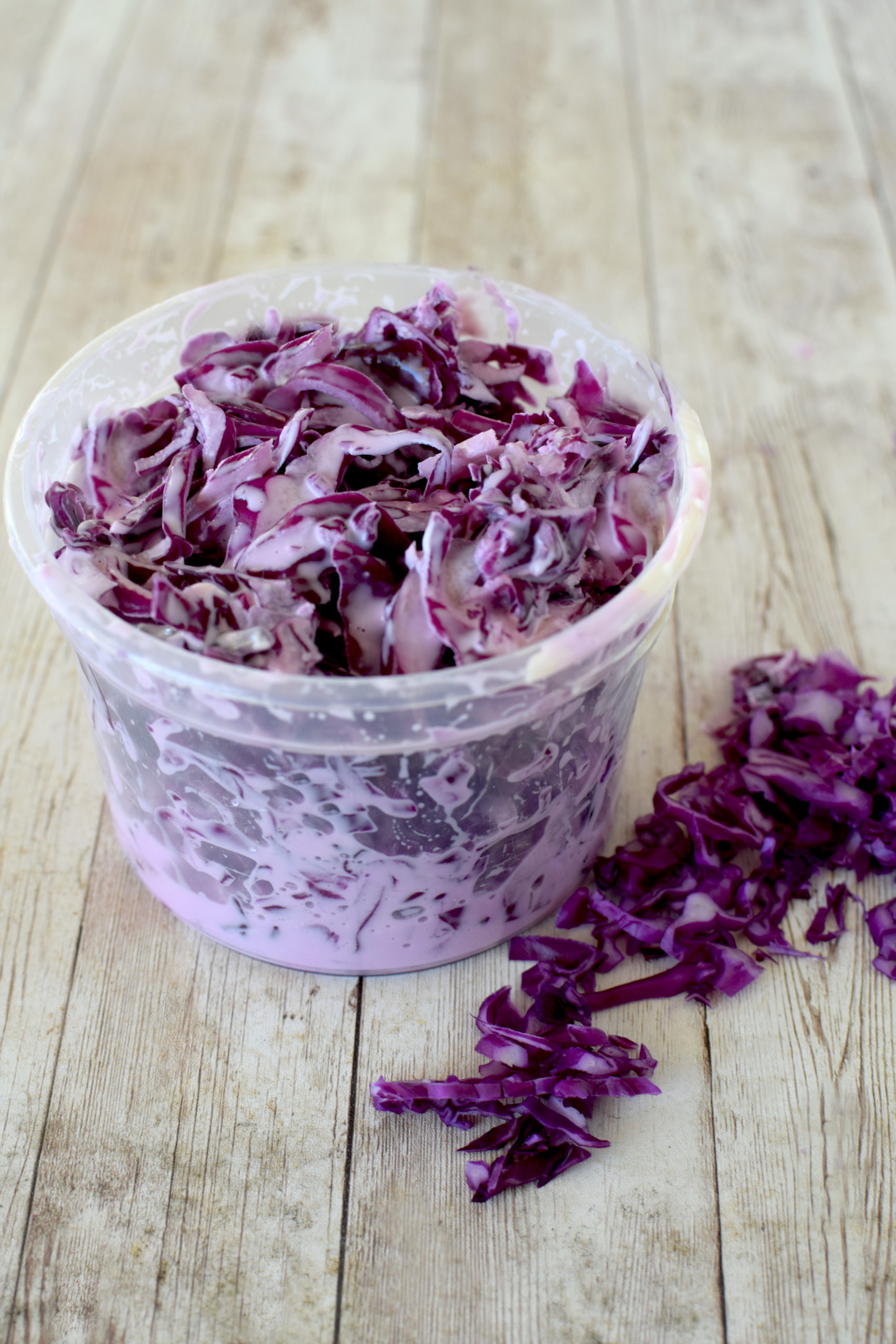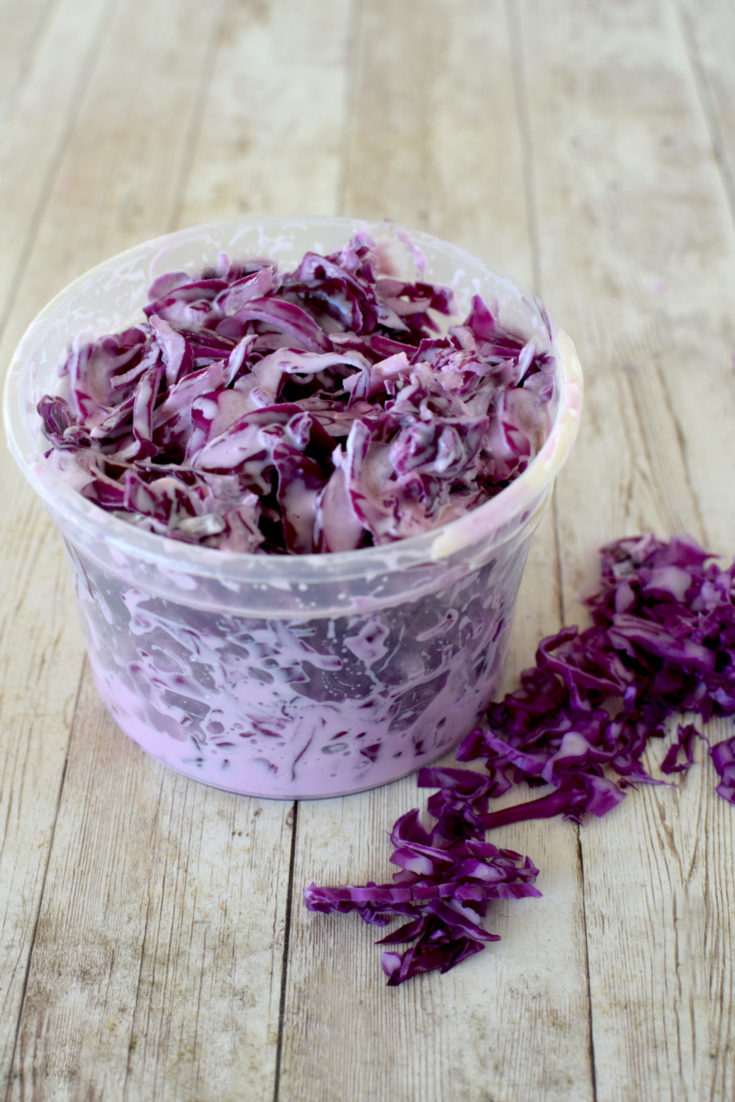Israeli Red Cabbage Salad With Mayonnaise for Passover is quick and simple to make. Just mix in your favorite kosher for Passover mayo and refrigerate, and you will have a terrific side for almost any Passover dish!

Israeli Red Cabbage Salad With Mayonnaise for Passover is a great side dish to add to any meal during the week of Passover or any time of the year.
A little of my cooking background
I really wanted to title this blog “If I can make it, anyone can” because, honestly, if I can make it, anyone can.
I never really liked cooking, and when I was single, a meal for me meant grilled cheese, eggs, tuna, or something else that didn’t require effort or time.
When my kids were young, I was still able to get away with preparing only a small variety of easy meals, but the older they got, the more dishes I learned to make at their request.
Still, I insisted on keeping it simple.
Honestly, I never understood why some cooks unnecessarily complicate meals. I have seen recipes that have several ingredients that don’t really seem to add much, if anything, to the dish. So, why bother?
It has always been important to me that whoever eats at my table will have plenty to enjoy, and that includes my kids (I never agreed with the “You will eat what is served or you won’t eat” ideology), and, because I keep it simple, I can prepare a variety of dishes in a relatively short period of time.
I have a philosophy regarding being a great cook: Prepare food according to the tastes of those who will be eating it, and they will love your cooking!
As far as I am concerned, start with the basic ingredients that make the dish what it is, adapt according to taste, and voila! You are an amazing cook!
The bottom line is that while there are certainly delicate recipes out there for specialty dishes, making delicious meals doesn’t have to be complicated or time-consuming. It’s not difficult to impress—just make sure it tastes good.
While some of the recipes on my blog are more time-consuming than others, they are all tried and true easy-shmeezy!
Of course, one always has to consider the conditions under which they cook. Weather (humidity, heat, cold), different types of ovens, different quality of pots, etc.—all of which can affect your cooking and baking.
Nevertheless, as I said, if I can do it, anyone can!
A little about Israeli cuisine
Some people complain about cultural appropriation in cuisine when food from one country is attributed to another country.
However, national cuisine in itself is often a mingling of food from of a variety of cultures, often due to a change of ruling countries and a shifting of borders.
Turkish cuisine, for example, goes back to the Ottoman Empire and was a combination of several cultures under Ottoman rule.
When people move from country to country, they will take their cultures with them and their decendents may adapt their traditional cuisine with that of their new home and, if they don’t, others might.
Chinese food in US restaurants is quite often not really authentic Chinese, but American Chinese.
Americans have created a whole variety of types and styles of pizza and pineapple pizza was apparently created in Canada by a Greek immigrant. Yet, everyone still calls them all “pizza”, which originated in Italy.
Spaghetti is thought to be an Italian food, but many historians believe that it was brought back to Italy from China by Marco Polo.
Apparently, battered fried fish was from the Portuguese Jewish community as a sabbath food and ended up in England via Holland during the Spanish Inquisition, yet everyone attributes the food to the British.
…and don’t get me started on Hummus.
When one lives in a melting pot, such as the US or Israel, it is just unrealistic to expect that food from a particular culture won’t mingle with that of other cultures.
That being said, “Israeli cuisine” is basically Middle Eastern (as opposed to Eastern European food) that was brought to Israel by Jews when they fled or were expelled from Muslim countries and moved to Israel mostly after the declaration of the State of Israel (collectively known as Mizrahi Jews).
Recipes were passed from generation to generation and, although decades have passed, the foods are still known by the culture they came from and everyone seems to have their own way of making them.
That said, there are many variations of pretty much any “Israeli” recipe, because of background, custom, or even just taste. When choosing a recipe, one has to know what actually constitutes a main ingredient – what makes the dish what it is – and what is left up to individual taste.
I personally find it very arrogant and quite irritating when a blogger(not naming names) will put “authentic” in the title of an “Israeli” recipe, as if all the rest are mere imitations. What’s worse, is when that blogger makes the recipe with her own twist and then calls it authentic!
Adding more or less of a spice or adding a spice that is not in the recipe, does not make it less authentic, but calling it “authentic” and then adding unnecessary extra ingredients above and beyond what needs to be there, is misleading.
For example, “authentic” Israeli salad (what Israelis call Israeli salad) is diced tomatoes and cucumbers. Sometimes, they will add some oil salt and pepper, but THAT’S IT. Anything else does not have to be there, but if you leave out the cucumbers or the tomatoes, you no longer have an “Israeli salad”.
So, find the recipes you like with the ingredients you prefer, add your own twists, and בתאבון (literally translated, “with appetite”) !
A little about red cabbage
While this vegetable is called “red” it is is mostly found in more of a purple color. It will change its color according to the PH value of the soil it grows in; in acidic soil, it will be more reddish and in more neutral soil, it will be more purple.
It is believed that red cabbage was first brought to Europe by the Celtics and was spread throughout Europe by the Romans. At first it was mainly used by peasants for themselves and their livestock and only began to appear in the food of the wealthy sometime in the 1700s.
Red cabbage has a high content of both vitamin C and vitamin K.
Just saying…
While some people have a talent for cooking, for some it can take a while of practice, trial, and error.
Everything I cook or bake is easy (or as some would say “stupid simple”) and most of my recipes have minimal ingredients and take minimal effort.
Many foods have a variety of recipes, based on tradition, location, family, or taste. While some ingredients are non-negotiable in a recipe, most can be tailored, so feel free to adjust the sugar and mayonnaise to suit your own taste (just remember that as the sugar melts and combines with the cabbage juices, it will taste sweeter than when you first add the sugar).
While I dislike making complicated recipes, passover brings with it its own set of challenges. I can’t even tell you how many times I have seen posts that ask for new ideas because someone’s family is tired of the same old food.
Food on Passover
Torah-observant Jews do not eat chametz (the fermented products of five grains: wheat, spelt, barley, oats, and rye).
In addition, Torah-observant Ashkenazi Jews do not eat kitniyot (or kitniyos as pronouced in Ashkenazi Hebrew). These include legumes, corn, rice, and similar foods that were deemed forbidden to eat by rabbis in the medieval period and are still not eaten today. Sephardi and Mizrachi Jews do not follow this tradition.
Many observant Ashkenazi Jews will not even eat the derivatives of these kitniyot, while others do (each family holds their own traditions regarding this).
Then, there are Ashkenazim who don’t eat “gebrokts” (or gebrochts).
Gebrokts means “broken” in Yiddish, and in this case refers to matzo that has absorbed liquid. Not eating gebrochts is observed by many in the Hasidic Jewish community and Ashkenazim who have taken on this tradition where they basically don’t mix anything wet with matzo.
So, things like matzo sandwiches, fried matzo, and even matzo balls are a no-no for them.
There is a joke that sums it all up:
On Passover, we should remember people who have little to eat on this holiday. They are called Ashkenazim.
Over the years, I have learned to adapt “normal” food for Passover so that my family won’t complain about boring, tasteless, or repetitive meals.
I find that having good food and variety makes the week of Passover a very pleasant experience, and I hope this recipe will help make yours just that!
Israeli Red Cabbage Salad With Mayonnaise for Passover

Easy Israeli style sweet red cabbage salad with mayonnaise for Passover
Ingredients
- 4 cups shredded red cabbage
- 3 tablespoons kosher for Passover mayonnaise (or more if desired)
- 1 tablespoons white granulated sugar (or to taste)*
Instructions
- Mix all ingredients together in a large mixing bowl.
- Refrigerate for 1/2-1 one hour to let the sugars release.
Notes
*While sitting, the juices from the cabbage and carrots will combine with the sugar and create a sweet dressing and will taste sweeter than when originally mixed, so don't overdue the sugar.
Nutrition Information:
Yield:
6Serving Size:
1Amount Per Serving: Calories: 53Total Fat: 2gSaturated Fat: 0gTrans Fat: 0gUnsaturated Fat: 1gCholesterol: 1mgSodium: 43mgCarbohydrates: 9gFiber: 3gSugar: 5gProtein: 2g